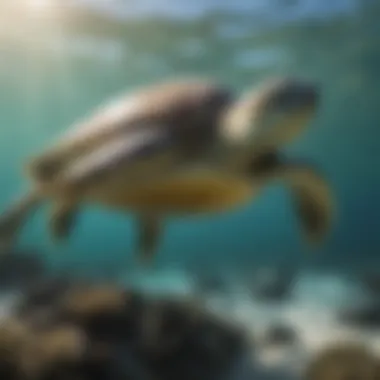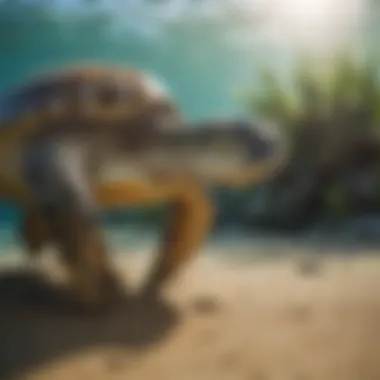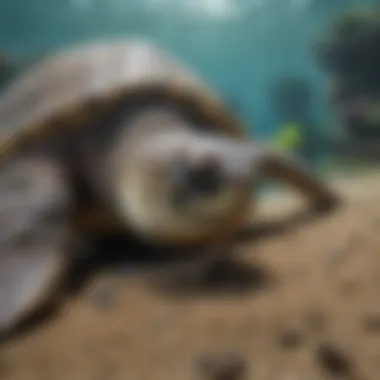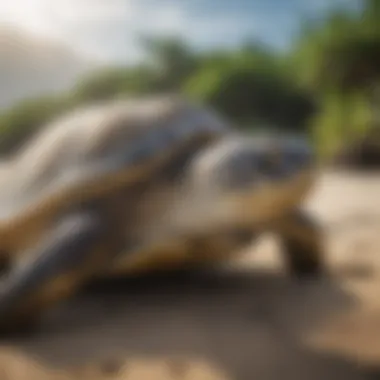Assessing the Endangerment Status of Green Sea Turtles


Intro
Green sea turtles are among the most recognized marine reptiles, distinguished not only by their physical attributes but also by their critical role in ocean ecosystems. As a species now classified as endangered, understanding their status requires a multifaceted approach. This involves delving into their biology, behavior, habitat, and the myriad of threats they face due to human activity. Each aspect builds a comprehensive picture of what makes conservation efforts essential for this iconic species.
Animal Overview
Common Names
The green sea turtle is known by several names, including the green turtle and Pacific green turtle. These names are reflective of the turtle's geographical presence and coloration.
Scientific Classification
Green sea turtles belong to the species Chelonia mydas. They form part of the family Cheloniidae, which includes other sea turtle species. Their classification reveals much about their evolutionary history and ecological niches.
Geographic Range
Green sea turtles inhabit tropical and subtropical oceans worldwide. Their range stretches from the coast of the Americas, across the Atlantic, to the coasts of Africa and Asia. They can often be found in areas like the Caribbean Sea, the Gulf of Mexico, and the Indian Ocean. Understanding their geographic range is crucial for assessing their endangerment status, as it informs conservation efforts targeted at specific populations.
Behavior and Social Structure
Social Behavior
Green sea turtles exhibit a mostly solitary lifestyle, although they may congregate in certain areas, especially during nesting season. Understanding their social structure is important for conservation strategies, as certain behaviors can influence their survival.
Communication
Communication among green sea turtles is subtle. They use body language and sometimes vocalizations to signal to one another, particularly during mating. Analyzing their communication patterns helps researchers assess the impact of environmental stressors on their social interactions.
Mating and Reproduction
Green sea turtles are known for their long migrations to nesting beaches. Females often return to the beach where they were born to lay eggs, a behavior called natal homing. The nesting process involves laying dozens of eggs, which face numerous threats even before hatching.
Habitat and Ecosystem
Natural Habitat
Green sea turtles prefer shallow waters, particularly near coral reefs and seagrass beds. These habitats provide essential shelter and feeding opportunities, making them critical areas for conservation planning.
Food Sources and Diet
The diet of green sea turtles primarily consists of seagrasses and algae. This herbivorous diet plays a pivotal role in maintaining the health of seagrass ecosystems. By grazing, they promote the growth of seagrass and contribute to the overall health of marine habitats.
Role in Ecosystem
As grazers, green sea turtles play a vital role in ecosystem balance. Their feeding habits help control algae growth, which in turn supports healthy seagrass beds. The decline of green sea turtles can lead to significant disruptions in these marine environments, highlighting the importance of their conservation for biodiversity.
The endangerment of green sea turtles is not just a loss of a species; it represents a larger imbalance in marine ecosystems that affects countless other life forms.
In summation, understanding the endangerment status of green sea turtles requires a thorough examination of their biology, ecology, and the threats they face. Continued research and conservation efforts are essential for the survival of this remarkable species.
Understanding Green Sea Turtles
Understanding green sea turtles is fundamental to assessing their endangerment status. This comprehension allows for effective conservation strategies and a deeper appreciation of their ecological significance. Green sea turtles are not just a species; they represent vital components of marine ecosystems. Their understanding includes their taxonomy, physical attributes, life cycle, and behaviors, which are crucial for wildlife protection initiatives.
Taxonomy and Classification


The scientific classification of green sea turtles places them in the kingdom Animalia, phylum Chordata, class Reptilia, order Testudines, family Cheloniidae, and the genus Chelonia. Specifically, the species name is Chelonia mydas. This classification illustrates their relationship with other turtles and reptiles and emphasizes their unique evolutionary traits. Recognizing the taxonomy is essential in conservation discussions. It provides insights into their relationships with other marine species and aids in the identification of conservation priorities, as some closely related species may also face similar threats. Furthermore, understanding their taxonomy helps in implementing international regulations protecting these turtles through trade and habitat conservation.
Physical Characteristics
Green sea turtles, known for their distinctive large, flat bodies, exhibit characteristics that support their adaptation to marine life. They can reach lengths of over one meter and weigh between 68 to 190 kilograms. Their carapace, or shell, is a unique olive to dark green color, providing them with camouflage against the ocean floor. These turtles also have strong, paddle-like flippers that facilitate efficient swimming.
Additionally, green sea turtles have a unique feature: their jaw structure allows them to feed primarily on seagrasses and algae, distinguishing them from other sea turtle species. Their physical attributes are crucial as they determine their feeding habits and habitat selection. Understanding these characteristics also sheds light on their struggles against threats like entanglement in fishing nets or habitat loss due to coastal development.
Life Cycle and Behavior
The life cycle of green sea turtles involves several distinct stages: hatchling, juvenile, and adult. Hatchlings emerge from eggs buried in sandy nests and head straight to the ocean, a perilous journey marked by numerous predators. After reaching the ocean, they enter a juvenile stage, which can last several years. During this phase, they feed in more sheltered waters, such as lagoons or estuaries.
As adults, they migrate long distances between feeding and nesting areas. Adult green sea turtles are known for their remarkable homing instincts, returning to the same beaches for nesting after years at sea. Behaviorally, these turtles exhibit complex social interactions and often play a role in maintaining the health of seagrass beds through their grazing activities.
Understanding their life cycle and behavior provides critical insights into their vulnerabilities and resilience. Knowledge of these life stages informs conservation efforts to protect nesting sites, optimize habitat conditions, and address potential human impacts.
By grasping the full breadth of the life cycle and biology of green sea turtles, conservationists can develop targeted protection programs and public awareness campaigns that stress the importance of preserving this endangered species.
Current Status of Green Sea Turtle Populations
The current status of green sea turtles is a critical aspect of understanding their overall endangerment. It encompasses various elements such as their geographical distribution, population trends, and the specific ways endangerment differs across regions. Grasping these aspects allows for a clearer picture of their survival and the broader ecological implications.
Global Distribution
Green sea turtles inhabit tropical and subtropical waters around the world. Their range extends from the coastal areas of the Americas to the Mediterranean Sea and the waters surrounding Africa and Australia. These creatures prefer shallow feeding grounds, such as sea grass beds and coral reefs. The geographical distribution is essential to understand because it highlights the areas most affected by climate change and human activity. The fact that these turtles migrate vast distances for nesting and foraging increases their exposure to varying threats. The health of specific ecosystems can greatly affect their populations, making it a significant consideration in conservation efforts.
Population Numbers and Trends
Current estimates suggest that green sea turtle populations have been declining over the years. Habitat loss, poaching, and climate change are primary contributors to this decline. Monitoring population numbers and trends provides insight into the effectiveness of conservation measures. It is not just about counting the turtles; it involves understanding the reasons behind fluctuations in these numbers. For example, areas with strict enforcement of protective measures tend to show more stable populations unlike those that lack proper legislation. Research indicates that in some regions, efforts like nesting site protection and community awareness programs have led to slight rebounds in numbers. Nevertheless, overall population trends remain worrying, showing that continuous efforts are required.
Geographical Variances in Endangerment
The endangerment status of green sea turtles is not uniform. Different geographical regions experience varied levels of threat based on local conditions. Factors such as fishing practices, coastal development, and pollution levels all play considerable roles in influencing their survival. For example, green sea turtles along the eastern coast of the United States have shown relatively better recovery rates due to stringent protections and management practices. Conversely, in regions where illegal poaching is rampant or where habitats are severely degraded, populations are struggling. Recognizing these variances is crucial for targeting conservation efforts effectively. Updating local strategies based on the specific needs of the turtles in different habitats can help manage and protect this endangered species more effectively.
Understanding the current status of green sea turtles is not just about numbers. It is a complex interplay of environmental, ecological, and human factors that demand focused attention and action.
Threats to Green Sea Turtles
Understanding the various threats to green sea turtles is essential for evaluating their status as an endangered species. As these reptiles face multiple challenges, it becomes crucial to address both the direct and indirect impacts that contribute to their decline.
Habitat Loss and Degradation
Habitat loss greatly affects the green sea turtle populations. Coastal development leads to the destruction of nesting sites on beaches. This impacts a turtle's ability to reproduce successfully. Moreover, the destruction of marine habitats, such as seagrass beds and coral reefs, further diminishes essential feeding grounds. With these ecosystems under threat, the survival rate of turtle populations declines.
Pollution and Marine Debris
Pollution remains a significant threat to green sea turtles. Plastics in the ocean pose serious hazards. Turtles mistake plastic bags for jellyfish, leading to ingestion that causes internal injuries or death. Chemical pollutants, including pesticides and heavy metals, accumulate in the turtles' bodies, harming their health and reproductive systems. Additionally, oil spills can have devastating effects on turtle habitats and their food sources.
Climate Change Impacts
Climate change poses a growing threat to green sea turtles and their environments. Rising sea levels threaten nesting sites, particularly in low-lying areas. Changes in ocean temperature affect the distribution of the turtles' food sources. Furthermore, altered weather patterns lead to more intense storms, which can damage nesting beaches. As temperatures rise, the sex ratio of hatchlings may be skewed due to the temperature-dependent sex determination, resulting in fewer males born.
Human Interactions
Human interactions have a profound impact on green sea turtles. Accidental bycatch in fishing gear poses a grave danger. Many turtles become entangled in nets or hooked on fishing lines, leading to injury or death. Illegal poaching for their meat, shells, and eggs continues to threaten populations. Moreover, recreational activities like boating and shoreline development can disrupt nesting and feeding areas, exacerbating the problem.
Effective mitigation of these threats is crucial for the survival of green sea turtles. Without decisive action, the future of this species hangs in the balance.


In summary, the threats faced by green sea turtles are interconnected and multifaceted. Addressing habitat loss, pollution, climate change, and human interactions is critical for their preservation. Understanding these threats can help in developing strategies for their conservation.
Conservation Efforts for Green Sea Turtles
Conservation efforts for green sea turtles play a crucial role in mitigating the threats that this endangered species faces. Protecting these turtles requires a multifaceted approach, involving legal regulations, international cooperation, local rehabilitation initiatives, and community participation. By strengthening these efforts, we can promote the survival of green sea turtles and protect the marine ecosystems in which they live.
Legal Protections
Legal protections are fundamental to the conservation of green sea turtles. Various national laws and international agreements exist to safeguard their habitats and prevent harmful activities. In the United States, the Endangered Species Act provides significant protections for green sea turtles. Under this act, harming, harassing, or killing these turtles is illegal. Furthermore, nesting sites are often included in protected areas to ensure the safety of eggs and hatchlings. Similar laws exist in other countries, adapting to local challenges and resources.
In addition, enforcing these laws can be challenging due to limited resources and varying levels of compliance. Monitoring activities in critical habitats remains essential. Local governments, NGOs, and conservationists must work together to ensure that laws are effectively implemented and violators face consequences. This cooperation is vital to establish a legal framework that sustains green sea turtle populations.
International Treaties and Agreements
International treaties and agreements are equally important for the conservation of green sea turtles, as these creatures migrate across international waters. The Convention on International Trade in Endangered Species (CITES) is a prominent treaty that limits the trade of turtles and their products globally. This treaty aims to prevent over-exploitation that could drive green sea turtles further towards extinction.
Additionally, regional agreements such as the Inter-American Convention for the Protection and Conservation of Sea Turtles facilitate cooperation among countries in the Americas. Such frameworks allow nations to share information, research findings, and conservation strategies. This collaborative effort strengthens the overall effectiveness of conservation initiatives, ultimately benefiting green sea turtles by fostering a coordinated approach.
Local Rehabilitation Projects
Local rehabilitation projects are essential for the immediate protection of injured or sick green sea turtles. Many coastal communities host rehabilitation centers that offer medical care and ensure safe environments for these turtles during recovery. These projects not only provide immediate aid to individual turtles but also contribute to educational programs that raise awareness about the species’ plight.
Successful rehabilitation often involves a combination of veterinary care, monitoring, and captive breeding where necessary. When these turtles are ready, they are often released back into their natural habitats. Such initiatives can serve as a model, promoting the idea that local communities can significantly impact conservation efforts.
Community Involvement in Conservation
Engaging local communities is vital for effective conservation of green sea turtles. Community involvement fosters stewardship, aligns local interests with turtle conservation, and raises public awareness about the importance of protecting these creatures. Numerous initiatives encourage individuals to participate in conservation activities, such as beach cleanups and nesting site protection.
Education plays a central role here. Informative workshops can help communities understand the ecological roles turtles play and the challenges they face. When people recognize the value of green sea turtles, it encourages participatory conservation efforts. Therefore, investment in community-led projects can create a sustainable framework for ongoing support for turtle conservation in the long term.
Investing in conservation is not simply an act of charity; it is an essential step towards preserving our planet's biodiversity.
In summary, conservation efforts for green sea turtles are multifaceted, involving legal frameworks, international cooperation, local rehabilitation, and community engagement. By addressing each aspect, we can create a robust strategy that enhances the survivability of green sea turtles and preserves marine environments. This collaboration is crucial in the ongoing effort to ensure that green sea turtles flourish for generations to come.
Ecological Importance of Green Sea Turtles
Understanding the ecological importance of green sea turtles is crucial for grasping their role in marine environments. Green sea turtles contribute significantly to the health of coastal ecosystems. Their behaviors and migrations affect various biological processes, making them integral to marine life.
Role in Marine Ecosystems
Green sea turtles help maintain the health of seagrass beds and coral reefs. By grazing on seagrasses, they promote growth and nutrient cycling, allowing these habitats to flourish. Grazing prevents overgrowth, which can smother other marine life, thus maintaining a balanced ecosystem.
Their foraging habits also impact the biodiversity of the areas they inhabit. For example, green sea turtles create habitats for smaller species by keeping seagrass short and healthy. This creates a more conducive environment for juvenile fishes and other organisms, thus supporting overall marine productivity.
“Green sea turtles act as a keystone species in their ecological niche, demonstrating how one species can heavily influence the environment around it.”
The presence of green sea turtles signifies healthy, functioning ecosystems. When turtle populations decline, it poses risks not only for the turtles but also for the marine life that depends on balanced environments.
Impact on Biodiversity
The impact of green sea turtles on biodiversity is profound. Their existence supports various species within the marine food web. Healthy populations help sustain ecosystems that encompass numerous organisms, emphasizing the interconnectedness of marine life.
Declines in green sea turtle populations can lead to disproportionate effects on biodiversity. For instance, when these turtles are removed from the ecosystem, we may witness overgrowth in seagrass and declines in fish populations, affecting local fisheries and the broader economy.
Maintaining healthy green sea turtle communities can aid in preserving the delicate balance of marine biodiversity. Conservation efforts focusing on these turtles can enhance resilience in ecosystems against changes such as climate shifts or pollution, ultimately benefiting myriad species, including those critical for human food sources.


In summary, green sea turtles are indispensable. Recognizing their role enhances our understanding of marine ecosystems and underscores the importance of conservation initiatives aimed at preserving these turtles and their habitats.
Future Prospects for Green Sea Turtles
The future of green sea turtles is an important aspect of understanding their endangerment status. These creatures face a range of challenges that threaten their survival, but also present opportunities for recovery and conservation. A clear assessment of what lies ahead involves recognizing emerging threats, innovations in conservation practices, and the long-term viability of turtle populations.
Emerging Threats
As environmental conditions change, new threats to green sea turtles emerge. One significant concern is the increasing frequency of extreme weather events, linked to climate change. These events can disrupt nesting sites, affect food availability, and reduce habitat quality.
The spread of invasive species poses another potential danger. For instance, some non-native plants can outcompete crucial nesting vegetation, leading to reduced nesting success. Additionally, the effects of ocean acidification on sea grass beds can diminish food resources for turtles.
Here are some of the key emerging threats:
- Climate Change: Rising temperatures affect nesting success and hatchling viability.
- Invasive Species: Non-native plants and animals disrupt local ecosystems.
- Overfishing: Reduces food supply while also increasing competition.
Innovations in Conservation Practices
In light of these threats, innovative conservation methods are becoming increasingly essential. New technologies provide powerful tools for monitoring turtle populations and habitats.
For example, satellite tracking enables researchers to follow migration patterns, helping to identify critical habitats. The use of drones for aerial surveys can efficiently assess the health of nesting sites without disturbing wildlife. Moreover, community-based conservation initiatives empower local populations to participate in protection efforts.
Some innovative approaches include:
- Technology in Tracking: Satellite and GPS technologies assist in understanding migratory routes.
- Habitat Restoration Projects: Initiatives focus on restoring and preserving essential habitats.
- Community Involvement: Engaging local people in education and conservation helps ensure long-term protection.
Long-term Viability and Monitoring
Continued monitoring and evaluation remain crucial for the long-term viability of green sea turtle populations. Establishing baseline data allows researchers to track changes over time, informing management decisions. It is not just about immediate threats; proactive measures can lead to sustainable populations.
Conservationists emphasize the importance of protecting nesting beaches and feeding areas. Regular monitoring can show trends that indicate the effectiveness of conservation strategies. Adaptive management practices can evolve based on findings to address ongoing challenges.
Important factors for maintaining viability include:
- Regular Population Assessments: Tracking numbers over time indicates recovery or decline.
- Protection of Critical Habitats: Securing areas vital for nesting and feeding.
- Research and Adaptation: Ongoing studies to refine conservation strategies.
These collective efforts are vital to ensuring that green sea turtles thrive in the future.
The path ahead for green sea turtles is complex but not without hope. By addressing threats, embracing innovative conservation techniques, and committing to rigorous monitoring, it is possible to improve their chances of survival and maintain the integrity of marine ecosystems.
Epilogue
The conclusion section of this article serves as a pivotal summarization of the critical insights gathered throughout the exploration of green sea turtles’ endangerment status. Understanding the ecological significance and the gravitas of threats these turtles face is essential. Their role in marine ecosystems cannot be overstated, as they influence health and balance.
Summary of Key Findings
This article highlights several key findings regarding green sea turtles:
- Green sea turtles are classified as endangered, facing multiple threats from human activities.
- Their habitats are crucial for various marine species, showcasing their role as a keystone species.
- Conservation efforts have made progress, but ongoing commitment is still required.
- Various international treaties and local rehabilitation efforts aim to protect these turtles.
An assessment of these findings reveals that without immediate and effective conservation actions, green sea turtle populations will continue to decline, resulting in significant ecological repercussions.
Call to Action
It is imperative for stakeholders, including policymakers, conservationists, and the public, to engage actively in the ongoing battle for the preservation of green sea turtles. Individual actions can create a ripple effect, fostering awareness and facilitating larger systemic changes.
- Support conservation organizations focused on marine life.
- Advocate for stricter regulations on pollution and habitat destruction.
- Educate others on the importance of protecting green sea turtles.
Collective efforts will be necessary to ensure the survival of this species for future generations. Proactive measures can mitigate the ongoing threats and enhance community involvement in conservation.
Engaging in the protection of green sea turtles is not just an ecological responsibility; it reflects our commitment to biodiversity and the health of our oceans.
Act now to safeguard these creatures and their habitats before it is too late.







